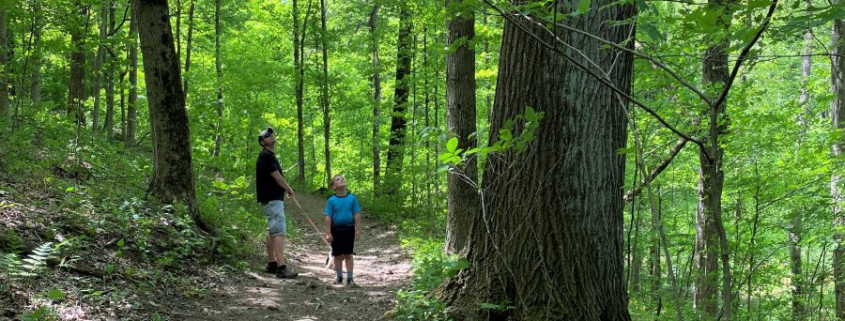Brush Creek Park in Beaver County Pennsylvania
May 23, 2021, I visited Beaver County Pennsylvania’s Brush Creek Park with my son (Matt) and grandson (Nathan). We hiked the 3.5-mile loop trail, viewing a dynamic forest populated with species familiar to my early-career forestry practice, teaching, and research days.

The only covered bridge in Beaver County, Brush Creek Park’s iconic wooden structure reaches across the creek. I am a lifelong fan of such bridges… their aesthetic elegance, the sound of footfalls echoing within their dry, protected shade, and the special nature of wood, the substance of our native trees. Carbon storage in service to pedestrian, horse, and cart traffic!
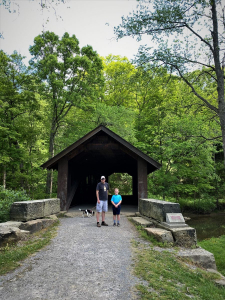
The trail transected much of the Park property, extending from approximately 900-feet elevation creekside to 1,150 at its highpoint. The trail is wide, evenly graded, and generally smooth. The lower-slope mixed hardwood forest is dominated by black cherry, mixed oaks, hickory, and maples. I love the meandering path through the woods. I felt a bit of melancholy as I fell behind the two generations surging ahead. Sure, I attributed my trailing, in part, to stopping to capture images. Yet, I knew another cause to be aging knees and a more faltering sure-footedness. The melancholy came with recalling years ago that it was I who slowed my pace for Matt to keep up, and occasionally offered a hand or even a shoulder-perch to traverse a similar trail. The Brush Creek Trail completed a loop, not unlike life itself which navigates its own full circuit.
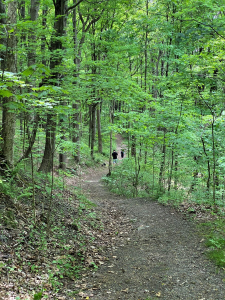
The foot-slope soils are deep, fertile, and moisture-rich. I marveled at the massive northern red oak we encountered!
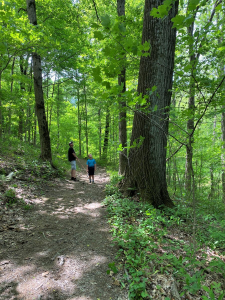
I conducted my doctoral research on the black cherry dominated Allegheny Hardwood forests of north-central and northwest Pennsylvania. Here in Beaver County I was at the periphery of the species’ core range, where it excels in growth, form, and value like no other place. Sure, we have black cherry in northern Alabama, but it is more scrub-like and of poor commercial value. My heart rate elevated to be back in black cherry’s preferred range. I suppose to readers who do not share my forestry roots, my emotion- and sentiment-connection to an individual tree species may seem odd. I had not given this near-spiritual relationship much thought prior to drafting this Post. I now see a future Post focusing on this special attraction to black cherry.
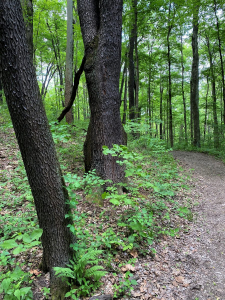
The trail crosses numerous wet weather drains protected from foot traffic by some well-designed and sturdily-constructed foot bridges.
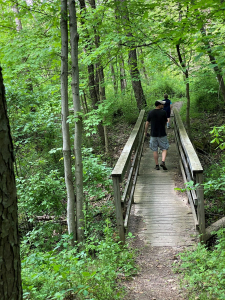
Sugar maple and black cherry stand shoulder to shoulder, 12 and 18-inches diameter, respectively (below left). Black cherry is shade intolerant, flourishing only when its crown reaches into the main canopy. Sugar maple tolerates shade, waiting patiently if necessary in the mid-canopy for some perturbation to free space above. The two crowns bear witness to the unique personalities of black cherry and sugar maple (below right). The black cherry resides in a canopy-dominant position (below right it is the left of the two stems). The sugar maple crown bends out to the photo’s right, most of its crown under the cherry’s full-sunlight position above it.
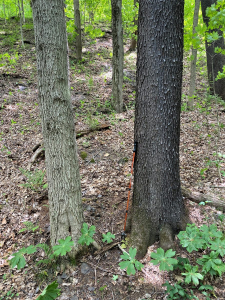
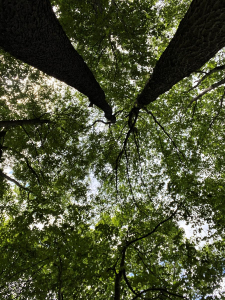
The sugar maple is patient, in large measure, because it is hard-wired to anticipate that its companion species will eventually fade. The black cherry above it may one day suffer the fate of this fallen black cherry, caught by its sturdy hickory neighbor. Somewhere above the fallen denizen a crown opening will soon fill-in, perhaps by a patient sugar maple below it.
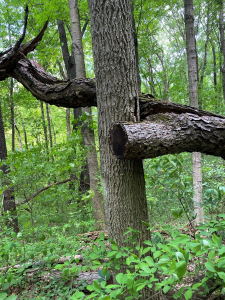
Senior Forest Citizens and Tree Form Oddities
At creekside we found two ancient sugar maples, both large and coarse. I’m guessing that they have stood sentry by the creek for at least two centuries.
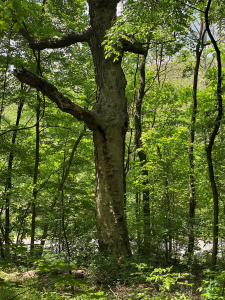
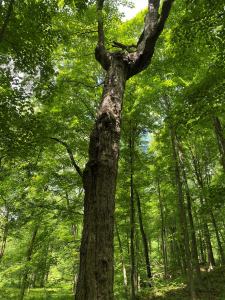
This old basswood likewise stands bankside at Brush Creek. These senior citizens, whether basswood or sugar maple, evidence the same coarse, wizened appearance, commanding deep respect and reverence from tree people like me. I felt moved to offer a silent salute and quiet moment of reflection.
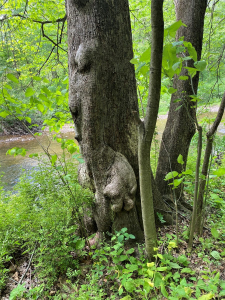
Life at bankside can be wrought with peril. These three intrepid souls hang on as periodic flooding erodes their perch. They will eventually transition from shoreline shade generators to woody stream debris. Life, whether human or tree, travels full circle with time.
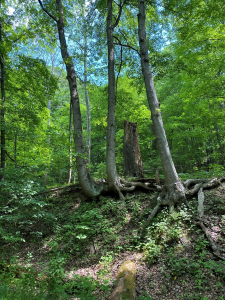
Black locust is a pioneer species across its range, colonizing disturbed areas with the first advance of woody species. The woodland we hiked still carries black locust relicts from past clearing, abandonment, and forest regeneration. Among many others we found these two locust skeletons. The remaining mixed species arrived and flourished in the second wave of tree conquest. The locust held on for as long as we can expect of a short-lived pioneer species. It served its purpose… and will once again be prepared to fulfill its mission if and when the current forest suffers some major disturbance.
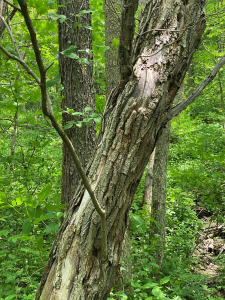
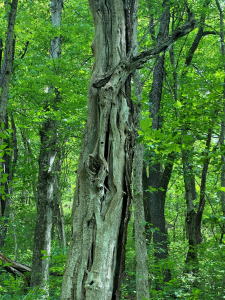
Sweeping change is, in fact, occurring. The emerald ash borer has already swept white ash from the Park. Bark is sloughing from the 18-inch ash (below left). A canopy void exists (below right) where its crown has shed leaves, twigs, and branches. Once more, the cycle spins.
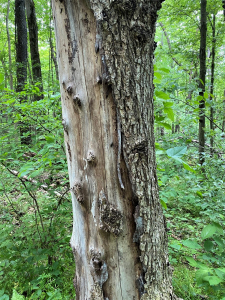

The borer’s larvae leave excavated galleries as they eat the living cambium beneath the bark. I mourn the loss of our white and green ashes as this introduced insect pest sweeps inexorably southward toward our Alabama forests. Our eastern USA hardwoods have suffered immeasurably from chestnut blight and Dutch elm disease, eliminating two foundation hardwood species. We now face a similar fate for our ashes. Nature will fill the void with other native species, but oh the price we pay for such devastating introduced insects and diseases.
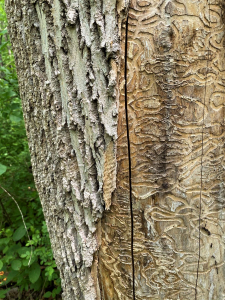
Intersection of Human and Natural History
At the trail’s highest reach we discovered this stone foundation that I suppose housed former residents from the days when the property was part of a working enterprise composed of cropland, pasture, and woodlots. Ah, if only these stones and the trees could talk! I’ve said often that every parcel, stand, and tree has a story to tell, enriched at the intersection of human and natural history.
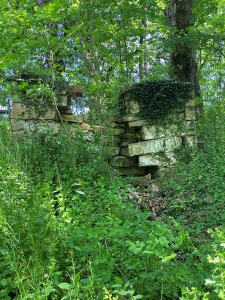
The bridge and its stone foundation likewise tell a story and, probably hold some secrets. Now, courtesy of a three-generation hike, Nathan has a story to share and perhaps lead a similar hike with a fourth generation…and beyond.


I am grateful for the chance to visit yet another special place…with special people.
Thoughts and Reflections
I offer these observations:
- Nature and our own lives move in circles and cycles… some stirring melancholy.
- I embrace my mission to share Nature and her tales with family… and beyond.
- Wherever I roam, Nature inspires and teaches lessons for life and living.
Inhale and absorb Nature’s elixir. May Nature Inspire, Inform, and Reward you!
Note: All blog post images created & photographed by Stephen B. Jones unless otherwise noted. Please circulate images with photo credit: “©2021 Steve Jones, Great Blue Heron LLC. All Rights Reserved.”
Another Note: If you came to this post via a Facebook posting or by an another route, please sign up now (no cost… no obligation) to receive my Blog Post email alerts: http://eepurl.com/cKLJdL
And a Third: I am available for Nature-Inspired Speaking, Writing, and Consulting — contact me at steve.jones.0524@gmail.com
Reminder of my Personal and Professional Purpose, Passion, and Cause
If only more of us viewed our precious environment through the filters I employ. If only my mission and vision could be multiplied untold orders of magnitude:
Mission: Employ writing and speaking to educate, inspire, and enable readers and listeners to understand, appreciate, and enjoy Nature… and accept and practice Earth Stewardship.
Vision:
- People of all ages will pay greater attention to and engage more regularly with Nature… and will accept and practice informed and responsible Earth Stewardship.
- They will see their relationship to our natural world with new eyes… and will understand more clearly their Earth home.
Tagline/Motto: Steve (Great Blue Heron) encourages and seeks a better tomorrow through Nature-Inspired Living!
Steve’s Three Books
I wrote my books Nature Based Leadership (2016), Nature-Inspired Learning and Leading (2017), and Weaned Seals and Snowy Summits: Stories of Passion for Place and Everyday Nature (2019; co-authored with Dr. Jennifer Wilhoit) to encourage all citizens to recognize and appreciate that every lesson for living, learning, serving, and leading is either written indelibly in or is powerfully inspired by Nature.
I began writing books and Posts for several reasons:
- I love hiking and exploring in Nature
- I see images I want to (and do) capture with my trusty iPhone camera
- I enjoy explaining those images — an educator at heart
- I don’t play golf!
- I actually do love writing — it’s the hobby I never needed when my career consumed me
- Judy suggested my writing is in large measure my legacy to our two kids, our five grand kids, and all the unborn generations beyond
- And finally, perhaps my books and Blogs could reach beyond family and touch a few other lives… sow some seeds for the future


All three of my books (Nature Based Leadership; Nature-Inspired Learning and Leading; Weaned Seals and Snowy Summits) present compilations of personal experiences expressing my (and co-author Dr. Wilhoit for Weaned Seals and Snowy Summits) deep passion for Nature. All three books offer observations and reflections on my relationship to the natural world… and the broader implications for society. Order any and all from your local indie bookstore, or find them on IndieBound or other online sources such as Amazon and LifeRich.

